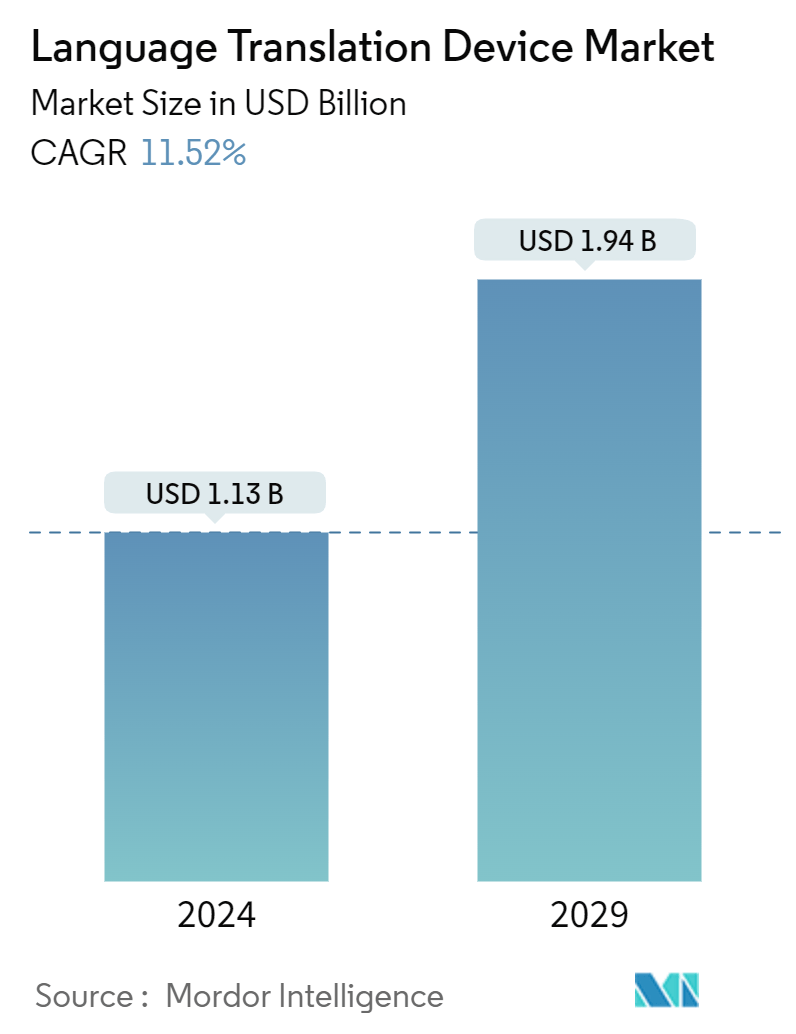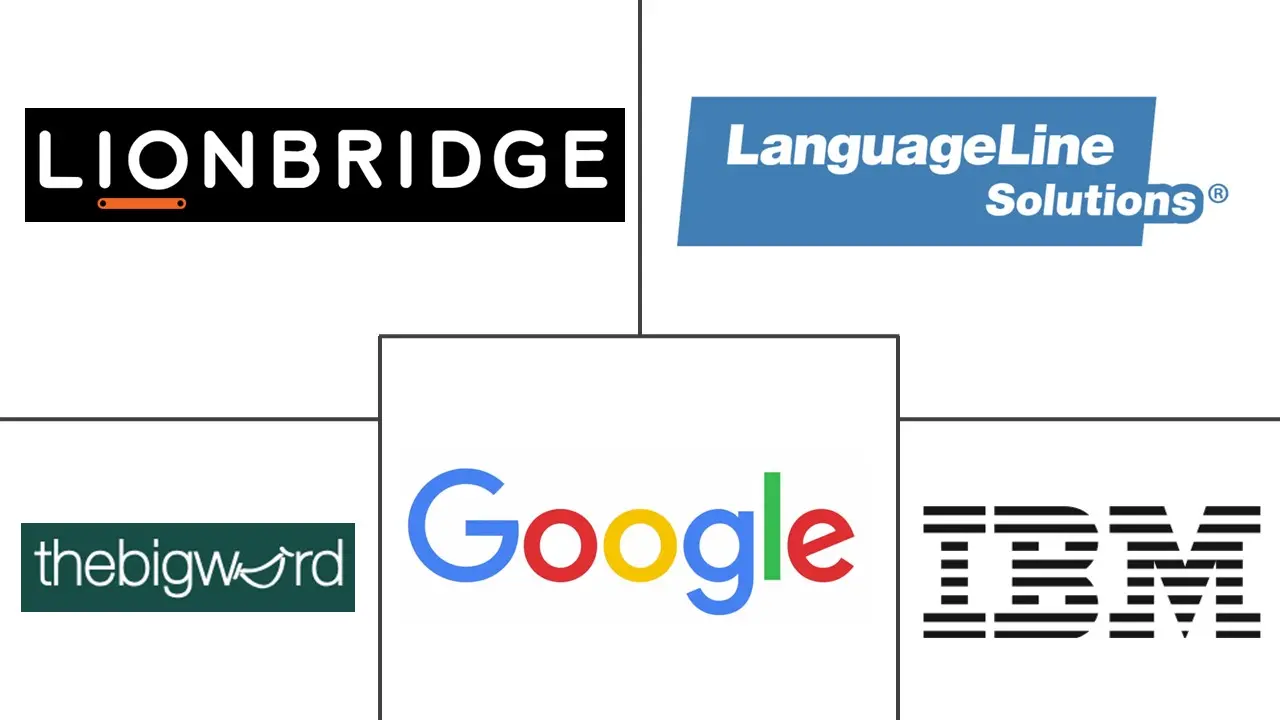Market Size of Language Translation Device Industry

| Study Period | 2019 - 2029 |
| Market Size (2024) | USD 1.13 Billion |
| Market Size (2029) | USD 1.94 Billion |
| CAGR (2024 - 2029) | 11.52 % |
| Fastest Growing Market | Asia Pacific |
| Largest Market | Europe |
Major Players
*Disclaimer: Major Players sorted in no particular order |
Language Translation Device Market Analysis
The Language Translation Device Market size is estimated at USD 1.13 billion in 2024, and is expected to reach USD 1.94 billion by 2029, growing at a CAGR of 11.52% during the forecast period (2024-2029).
- The growing international departures drill well for the language translating devices market as an increasing number of travelers are choosing destinations away from home with a different language. Moreover, the language translating devices market is experiencing tremendous technological transformations, revving sales of language instruments worldwide. Similarly, the increasing popularity of online information pursuits may boost demand for language translation software and services. Further, the increasing medical tourism is one of the main driving factors for the development of the target market.
- According to 10 Times, With over 33 thousand events published on an event platform from May 2022 to April 2023, the United States has the most conferences, business meetings, and trade exhibitions scheduled. The United Kingdom was the second-place finisher, which hosted 6.4 thousand events across all sectors. According to a recent study from LinkedIn, the largest professional network in the world, 45% of future B2B events will be entirely virtual. In the study of 200 B2B event organizers in the UK, 72% of companies want to continue hosting virtual events over the long term, and 77% are interested in hosting hybrid events. Such a huge number of events would drive the demand for the studied market.
- According to the Office of Travel and Tourism, Tourist Arrivals in the United States were 49,96,037 in June 2023. Further, as per Trading Economics, Tourist arrivals in Slovenia rose 10.6 percent year-on-year to 510,096 in May 2023, following a 16.6% growth in the prior month. Such a huge rise in the number of tourists would push the hospitality sector to adopt the latest Language translation devices to provide better services to its customers.
- Hybrid language translation hardware can perform translation operations in both offline and online modes. Such devices can work without network connections and enhance their capabilities through server-based operations. Moreover, in offline mode, hybrid devices can perform a small translation scale, whereas, in online or server-based connectivity, they can perform complex translations of speeches.
- For example, Lingmo International launched an IBM Watson-powered earpiece language translator to translate conversation without using the internet in a remote location like an airplane. It uses Watson Natural language programming, is priced at USD 179, and is useful for users ranging from travelers to the military.
- On the contrary, language translation devices rely on machine learning and artificial intelligence (AI) algorithms to deliver translations, with significant progress made towards reaching perfect accuracy and quality translations; yet reaching this goal remains difficult due to translating complex sentences, idioms, or context-specific phrases accurately proving difficult for machine translation systems, leading to potential errors and inaccuracies that compromise accuracy and quality in translations.
Language Translation Device Industry Segmentation
A language translation device is a technology used to translate languages from one to another. Many types of language in the market contain simple phrasebooks and complex and complicated computer software programs. Among these devices, one of the most popular ones is an electronic translator.
The language translation device market is segmented by product type ( handheld, wearable) and geography (North America, Europe, Asia Pacific, Latin America, and Middle East and Africa).
The market sizes and forecasts are provided in terms of value USD for all the above segments.
| By Product Type | |
| Handheld | |
| Wearable |
| By Geography*** | |
| North America | |
| Europe | |
| Asia | |
| Australia and New Zealand | |
| Latin America | |
| Middle East and Africa |
Language Translation Device Market Size Summary
The language translation device market is poised for significant growth, driven by increasing international travel and the rising demand for effective communication across language barriers. As more travelers venture to destinations with different languages, the need for advanced translation devices becomes crucial. Technological advancements in translation devices, including hybrid models that operate both online and offline, are enhancing their capabilities and expanding their applications. The surge in medical tourism further propels the market, as patients seek healthcare services abroad and require translation devices to navigate language differences. The healthcare sector's focus on international recognition and the integration of translation devices in medical facilities underscore the market's potential.
In Europe, the demand for language translation devices is bolstered by the continent's status as a leading tourist destination and the diverse linguistic landscape of the European Union. The region's robust tourism industry and the increasing adoption of e-commerce platforms necessitate effective translation services to facilitate communication and enhance customer experiences. The market is characterized by moderate consolidation, with key players like Lionbridge Technologies, Google Inc., and IBM Corporation investing in strategic partnerships and technological innovations. Recent developments, such as AI-powered features in translation applications and advanced translation technologies, highlight the industry's commitment to improving accuracy and user experience. As businesses and individuals increasingly seek translation services, the market is expected to continue its upward trajectory.
Language Translation Device Market Size - Table of Contents
-
1. MARKET INSIGHTS
-
1.1 Market Overview
-
1.2 Industry Attractiveness - Porter's Five Forces Analysis
-
1.2.1 Bargaining Power of Buyers
-
1.2.2 Bargaining Power of Suppliers
-
1.2.3 Threat of New Entrants
-
1.2.4 Threat of Substitutes
-
1.2.5 Intensity of Competitive Rivalry
-
-
1.3 Industry Value Chain Analysis
-
1.4 Assessment of the Impact of COVID-19 on the Market
-
-
2. MARKET SEGMENTATION
-
2.1 By Product Type
-
2.1.1 Handheld
-
2.1.2 Wearable
-
-
2.2 By Geography***
-
2.2.1 North America
-
2.2.2 Europe
-
2.2.3 Asia
-
2.2.4 Australia and New Zealand
-
2.2.5 Latin America
-
2.2.6 Middle East and Africa
-
-
Language Translation Device Market Size FAQs
How big is the Language Translation Device Market?
The Language Translation Device Market size is expected to reach USD 1.13 billion in 2024 and grow at a CAGR of 11.52% to reach USD 1.94 billion by 2029.
What is the current Language Translation Device Market size?
In 2024, the Language Translation Device Market size is expected to reach USD 1.13 billion.

